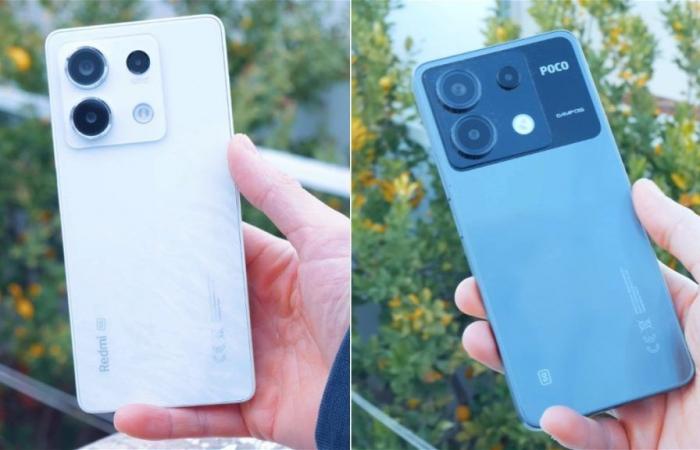We confront these economical mid-range mobiles with 5G to discover which is the best choice if you are looking for a new terminal for about 250-300 euros
Join the conversation
In this article we bring you a comparison between the Redmi Note 13 5G and the POCO X6 5G, among the best alternatives if you are looking for a new economical mobile phone with 5G connectivity. Both terminals share a price, 279.99 euros for the models with 8 GB of RAM and 256 GB of memory, but they have big differences that come to light in this comparison and that make one of them a better choice than the other.
Design, screen, hardware, cameras… There are many aspects that you should take into account when choosing between the Redmi Note 13 5G and the POCO X6 5G, and we value all of them in this comparison. After seeing what each smartphone offers you in each of the sections, you will be able to decide which is the best purchase for you. We will also help you in the choice choosing which is the best mobile in general terms.
Comparative table of features
| Specifications | Redmi Note 13 5G | POCO X6 5G |
|---|---|---|
| Dimensions | 161.11 x 74.95 x 7.6mm | 161.15 x 74.24 x 7.98mm |
| Weight | 174.5 grams | 181 grams |
| Screen | 6.67-inch Full HD+ AMOLED (2,400 x 1,080 pixels) Refresh rate up to 120 Hz Maximum brightness of 1,000 nits Corning Gorilla Glass 5 | 6.67-inch AMOLED DotDisplay 1.5K (2712 x 1220 pixels) 120Hz refresh rate 2160Hz touch sampling rate Typical brightness 500 nits, maximum up to 1800 nits Corning Gorilla Glass Victus 10-bit color depth DCI-P3 |
| Processor | MediaTek Dimensity 6080 | Qualcomm Snapdragon 7s Gen 2 |
| RAM | 6/8GB LPDDR4X | 8/12GB LPDDR4X |
| OS | MIUI 14 based on Android 13 | MIUI 14 based on Android 13 |
| Storage | 128/256 GB UFS 2.2 | 256/512GB UFS 2.2 |
| Cameras | Rear: 108 MP main f/1.75 8 MP ultra wide angle f/2.2 2MP macro Frontal: 16 Mpx | Rear: 64 Mpx main with OIS 8 Mpx ultra wide angle, 120 degree viewing angle 2 Mpx macro Frontal: 16 Mpx |
| Battery | 5000mAh 33W fast charging 33W charger included | 5100mAh 67W fast charging 67W charger included |
| Connectivity | Dual SIM 5G Wi-Fi 6 Bluetooth 5.3 NFC GPS | Dual SIM 2G, 3G, 4G, 5G Bluetooth 5.2 Wi-Fi 802.11 a/b/g/n/ac/ax |
| Others | USB-C 3.5mm headphone jack Side fingerprint reader IP54 | On-screen fingerprint reader Double speaker Infrared NFC Face unlock 3.5mm headphone port |
Design
The Redmi Note 13 5G and the POCO X6 5G have a key difference in design which allows us to differentiate them at first glance. On the one hand there is the Redmi terminal, which has a square module for the rear cameras that does not occupy the entire width of the case. On the other hand, there is the POCO phone, which is betting on a rectangular module for cameras that it does take up most of the width from his rear.
Therefore, we can say that this camera module represents the big difference between the aesthetics of the Redmi Note 13 5G and that of the POCO X6 5G. These mid-range phones too They differ in the range of colors in which they are available. The Redmi one can be purchased in black, white and greenwhile POCO’s has hit the market in black, white and blue.
Beyond these details, the Redmi Note 13 5G and the POCO X6 5G are similar in terms of design. Both opt for straight lines, with very thin and light bodies. However, it is worth mentioning that The Redmi Note 13 5G has a smaller thickness (7.6 versus 7.98 millimeters) and lighter weight (174.5 vs. 181 grams). Therefore, its use may be slightly more comfortable, although the difference is not very notable.
Finally, there is another difference that may be important in your choice. This is related to the fingerprint reader locationlocated on the right side in the Redmi Note 13 5G and on the screen in the POCO X6 5G.
Screen
The screen is one of the big differences between the Redmi Note 13 5G and the POCO X6 5G. The first of them equips a 6.67-inch AMOLED panel with Full HD+ resolution (2,400 x 1,080 pixels), 120 hertz refresh rate and a brightness that reaches 1,000 nits. On the other side is the POCO X6 5G, with a 6.67-inch AMOLED screen with 1.5K resolution (2712 x 1220 pixels), 120 hertz refresh rate and a 1,800 nits peak brightness.
The comparison confirms that the screen of the POCO X6 5G is better than that of the Redmi Note 13 5G, both in theory and in practice. The images offered are sharper and achieve higher brightness, allowing the user to see them more clearly in brightly lit scenarios. Therefore, the POCO X6 5G is a better choice if the screen is a fundamental section for you.
Hardware and software
The POCO X6 offers very good performance on a daily basis | Photography by Juan Antonio Morales Gil
If we pit the Redmi Note 13 5G against the POCO X6 5G, some hardware-related differences also come to light. On the one hand, the Redmi terminal equips a MediaTek Dimensity 6080 processorwhile POCO’s has a Qualcomm Snapdragon 7s Gen 2 processor. The victory in this section goes to the POCO X6 5G, since its processor offers a more powerful performance In day to day.
The Redmi Note 13 5G is a smartphone that you can use for the most everyday tasks, such as chatting, viewing social networks, browsing or listening to music. However, the POCO X6 5G goes one step further and, for the same price, it also allows you play or edit images with a certain fluidity thanks to that extra power provided by the Snapdragon 7s Gen 2.
The differences between the Redmi Note 13 5G and the POCO X6 5G also go through the memory configurations in which they are available. The first of them allows us to choose between the model with 6 GB of RAM and 128 GB of storage, and 8 GB of RAM and 256 GB of storage. The options are broader with the POCO X6 5G, which can be purchased with 8 GB of RAM and 256 GB of memory, with 12 GB of RAM and 256 GB of memory, and with 12 GB of RAM and 512 GB of storage.
The features are equal if we focus on the software, since both the Redmi Note 13 5G and the POCO X6 5G arrive with MIUI 14 based on Android 13. This is one of the weakest points of both, which lose 1 year of updates until you receive HyperOS with Android 14.
Autonomy and charging
The autonomy of the Redmi Note 13 5G can easily overcome the day / Photography by Juan Antonio Morales Gil
The POCO X6 5G is also slightly ahead in this section, both in terms of battery capacity and the fast charging it supports. Specifically, the Redmi Note 13 5G equips a 5,000 mAh battery allowing you to get to the end of the day without complications. Although the difference in practice is not huge, the POCO X6 5G is a step above when mounting a 5,100 mAh battery.
In addition, the charging of the POCO phone is much higher than the charging of the Redmi. And the POCO X6 5G supports 67W fast charging, so it needs just over half an hour to reach 100% energy. However, the Redmi Note 13 5G settles for a 33W fast chargingso it requires about an hour and a quarter to complete the charge.
Cameras
A 64 MP camera leads the POCO X6 5G camera system | Photography by Juan Antonio Morales Gil
The differences between the Redmi Note 13 5G and the POCO X6 5G also go through their photographic system. In fact, the difference is present in the most important camera, the main one on the rear. The Redmi Note 13 5G equips a 108 megapixel main lenswhile the POCO X6 5G has a 64 megapixel main camera. There is an aspect that works in favor of the latter, and that is that Yes, it has an optical image stabilizer..
In practice, the difference between the results of these cameras is not that great. With both you can capture good quality photos during the day, and somewhat more limited when night falls. However, there is another aspect that works in favor of the POCO X6 5G camera, and that is that it can record videos in 4K resolution. However, the camera of the Redmi Note 13 5G is limited to recording in Full HD.
Beyond these differences (megapixels, stabilizer and video recording), the cameras of the protagonists of the comparison are very similar. Both complete the rear module with a sensor 8 megapixel ultra wide angle and a sensor 2 megapixel macrowith a camera 16 megapixel front for selfies.
Redmi Note 13 5G vs POCO X6 5G: which is better?
The conclusion of this comparison is that the POCO X6 5G is better than the Redmi Note 13 5G. The POCO terminal is ahead in key sections such as screen, processor, battery and fast charging. In fact, the experience it offers is so good that we think it is one of the phones with the best quality-price ratio on the entire market.
This POCO X6 5G part of the 299.99 euros in the base model, with 8 GB of RAM and 256 GB of internal storage. However, typically you can buy it even cheaper in AliExpress Plaza, in Amazon, in PcComponentes, in MediaMarkt and in the official Xiaomi store.
POCO X6 5G
See on Amazon.es: POCO X6 5G
Redmi Note 13 5G
See on Amazon.es: Redmi Note 13 5G
Before finishing this comparison, it must be mentioned that the Redmi Note 13 5G is still a good buy if you are looking for a cheap smartphone with 5G. As we have seen, it has a good screen, offers good performance for everyday use and shines with its 108 megapixel main camera.
This Redmi Note 13 5G is available in 2 memory configurations: 6 GB of RAM and 128 GB of storage for 279.99 eurosand 8 GB of RAM and 256 GB of storage for 299.99 euros. It is for sale on Amazon, on AliExpress, on PcComponentes, on El Corte Inglés, on MediaMarkt and on the Xiaomi website, it has many stores to choose from to get it.
You can follow Andro4all on Facebook, WhatsApp, Twitter (X) or check our Telegram channel to stay up to date with the latest technology news.
Join the conversation
This article suggests objective and independent products and services that may be of interest to readers. When the user makes a purchase through the specific links that appear in this news, Andro4all receives a commission. Join the Andro4all deals channel to find out about the best offers before anyone else.






